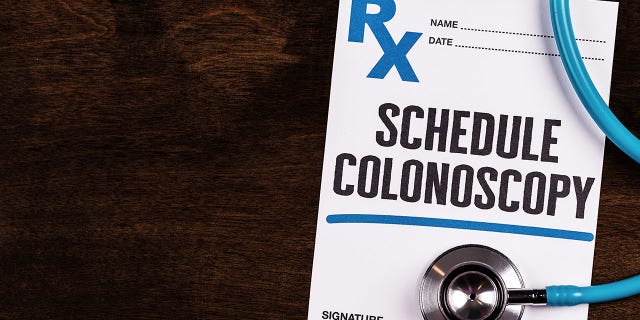NEWYou can now listen to Fox News articles.
Blink-182 drummer Travis Barkerrevealed on Instagram what endoscopy is, although his recent hospitalization for pancreatitis was after endoscopy. Did.
"I had an endoscopy on Monday and I feel good, but after dinner I felt intolerable pain and have been hospitalized ever since." 46 The old man said in an Instagram article on Saturday. , July 2nd.
"During endoscopy, we resected a very small polyp in a very sensitive area, usually by a specialist and unfortunately damaged an important pancreatic drainage tube. This caused severe, life-threatening pancreatitis. "
He is now recovering and is doing much better.

Travis Barker and Kourtney Kardashian arrive at The 2022 On May 2, 2014, I met a gala celebrating "In America: Fashion Anthology" at the Metropolitan Museum of Art in New York City. He is now recovering from pancreatitis after endoscopy damage to an important pancreatic drainage tube. (Photo by Gilbert Carrasquillo / GC Images)
TRAVIS BARKER HOSPITALIZED FOR PANCREATITIS: REPORT
The gastrointestinal tractis a "long twisted tube" that extends from the mouth, stomach, and small intestine to the large intestine and consists of the cecum, colon, and rectum. , According to the National Institute of Diabetes, Gastroenterology and Kidney Disease.
Endoscopy is as follows: "Procedures for examining the body using an endoscope. An endoscope is a thin tubular instrument with a light and a lens for display. It may also have a tool. The endoscope is sick. Remove the tissue that checks for signs. "
Upper gastrointestinal endoscopy, also known as upper gastrointestinal endoscopy (EGD), is a procedure that examines the upper gastrointestinal tract, including the first part of the esophagus, stomach, duodenum, or small intestine. American College of Gastroenterology (ACG).
According to ACG, it is common when a patient is bleeding in the upper gastrointestinal tract due to persistent heartburn, nausea or vomiting, abdominal pain or dysphagia.
EGD is considered a safe procedure, but each ACG can cause complications such as lacerations, bleeding or infection of the esophagus, stomach or lining of the duodenum.
Another type of endoscopy is known asendoscopic retrograde cholangiopancreatography, or ERCP, which treats bile and pancreatic duct problems according to ACG. It is inserted from the patient's mouth to the small intestine.

Upper Gastrointestinal Endoscopy (EGD)) According to the American College of Gastroenterology (ACG), it is a procedure to examine the upper gastrointestinal tract, including the esophagus, stomach, duodenum, or the first part of the small intestine. (iStock )
Pancreatitis by manipulating the pancreatic duct opening (magnitude) from the scope rather than trauma by pressure on the pancreas itself May cause. Dr. Kanwagil, a gastroenterologist at John Muir Health in Northern California, told Fox News.
"The most common reason [of ERCP] is to find and remove gallstones that have clogged the bile ducts. Another common reason is acute pancreatitis (pancreatic inflammation or inflammation). Is to look for the cause of the bile duct or pancreatic tumor, if the bile duct cannot be drained, remove the obstruction of the bile duct and treat the leakage of the bile duct or pancreatic duct, "said ACG.
Barker did not specify the type of endoscopy, but an ampoule resection, which means removing the ampoule (the drainage site of the pancreatic and bile ducts) where adenomas are common, can be done. did it. , Gil said.
"For deep small bowel endoscopy, such as a double balloon or single balloon scope, the length [of the gastrointestinal tract] is to check for small bowel problems. The concept is pressure trauma and It's the same. It causes pancreatitis] ".
What is pancreatitis? Symptoms, Causes, and Treatment
However, colonoscopy is finally done by the operator using a flexible instrument with a camera, the colonoscope. Allows you to actually evaluate the whole thing. Time to go through the scope.
Colon endoscopy screens forcolon cancerand various disorders of the gastrointestinal tract, including colon polyps, inflammatory bowel disease, bleeding, and changes in bowel habits. Diagnose and / or evaluate. , Abdominal pain or obstruction, ACG added.
According to ACG, colonoscopy is "very safe" when performed by a well-trained physician, who is often a gastroenterologist.
"Very rare, most [colon endoscopy] complications are associated with sedative administration (heart and respiratory problems). The colon is also partially torn (perforated). This may require surgery, "says ACG.
"In rare cases, removal of the polyp or bleeding from the procedure itself may require additional treatment, such as hospitalization or blood transfusion."

The previous recommendation is that most Americans should have a colonoscopy by age 50. Once started, the US Preventive Services Task Force currently recommends 45 years of age unless the patient has colorectal symptoms, a family history of colorectal cancer, polyps, or inflammatory bowel disease. (iStock)
LANDON BARKER participates in machine gun kelly on stage at NYCAMID DADTRAVIS BARKER reported hospital
The previous recommendation was that most Americans should start colonoscopy by the age of 50, but the US Preventive Services Task Force now gives patients colorectal rectum. Unless you have symptoms, we recommend 45 years old. Colon cancer, polyps or inflammatory bowel disease.
Click here to get the FOX News app
"First-degree relatives (parents, If there is more than one sibling) or if the child) has precancerous polyps or colon cancer, the general guideline is either 10 years younger or 40 years younger than the youngest age in the colon cancer family. Start screening for colorectal cancer younger than younger.
"There are additional guidelines forwith suspected or confirmed rare syndromes. Discuss these options with your doctor. Must be. "


